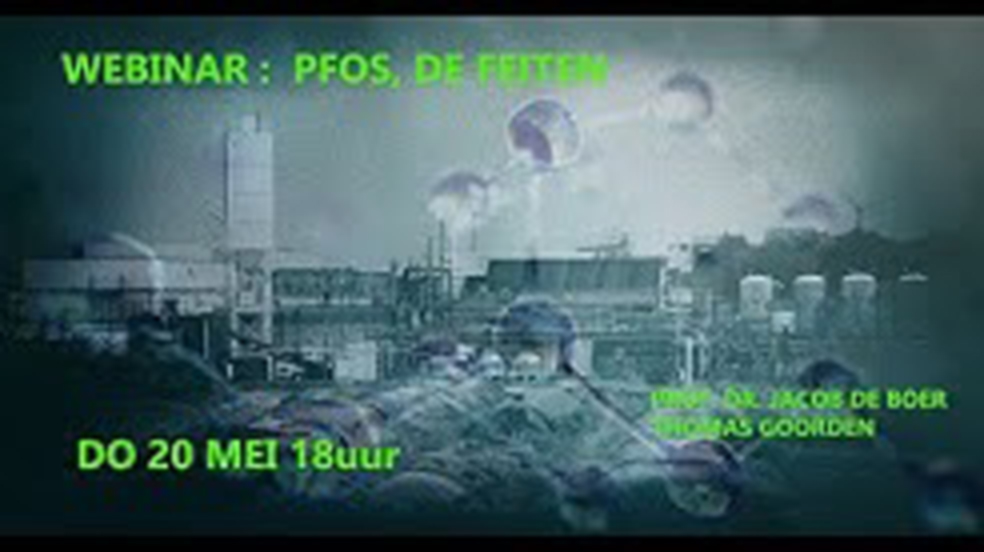05.01.2022 | Fundamental right
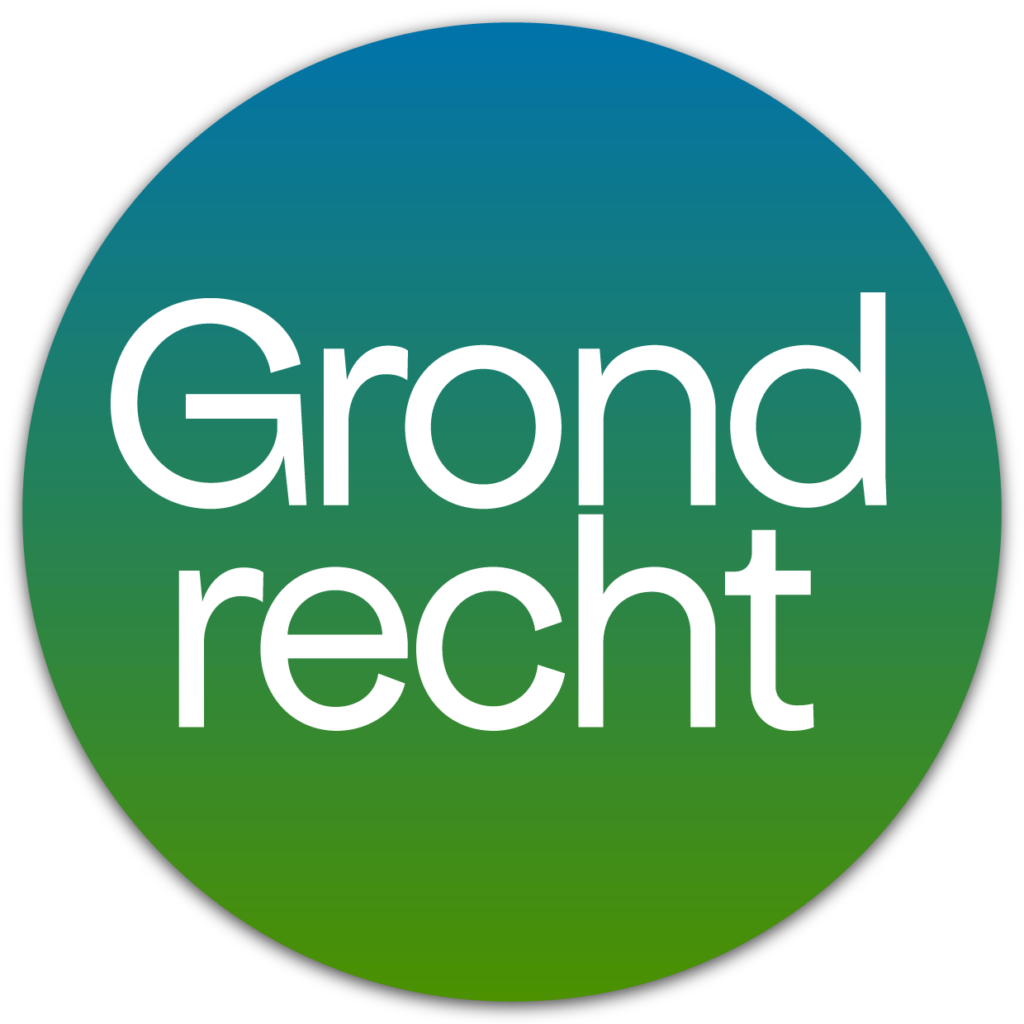
Manual + objection letter
Omgevingsvergunning Lot2a_COTU_ST W1_Wijziging VW_MIL – OMV 2021160028 – COTU
Thank you for your commitment to submitting the objection below.
Please follow the steps below:
STEP 1. GO TO THE ENVIRONMENTAL DESK.
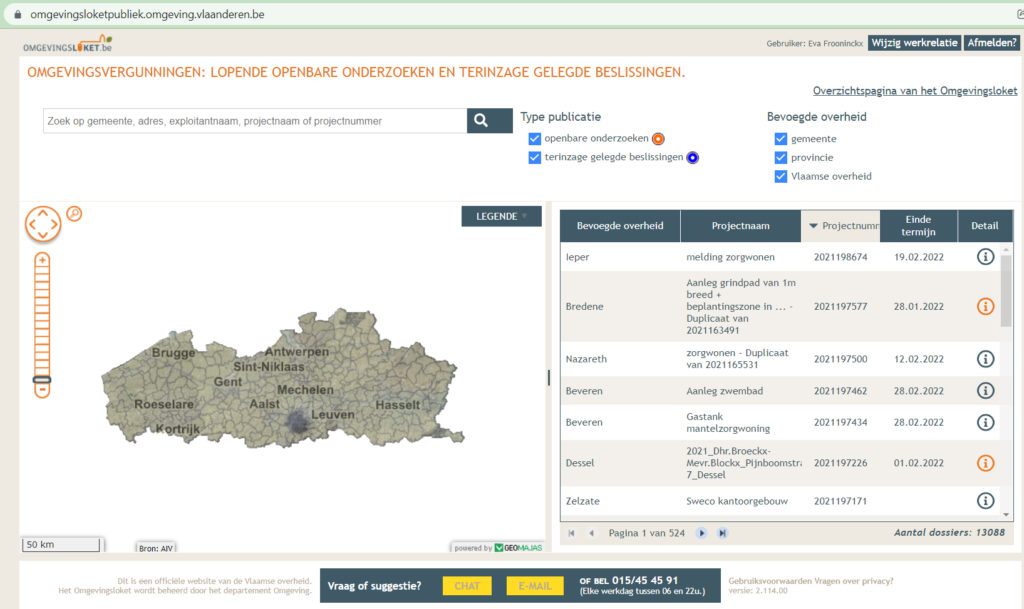
STEP 2. SEARCH FOR
- Enter the project code “ in the search box at the top left2021160028” in
- select “Lot2a_COTU_ST W1_Wijziging VW_MIL (2021160028)” uit de popup-lijst onder het zoekvenster
the project now appears in the list on the right side

2.
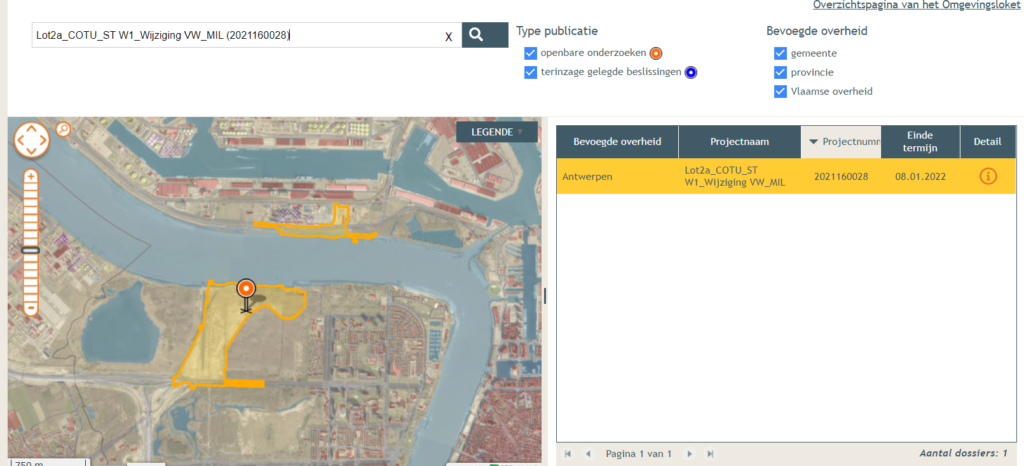
STEP 3. SELECT THE PROJECT.
Click on the 'information button' behind the project in the box on the right.
Project number: 2021160028
Click on the  behind the project.
behind the project.

All details and documents of this project will appear:
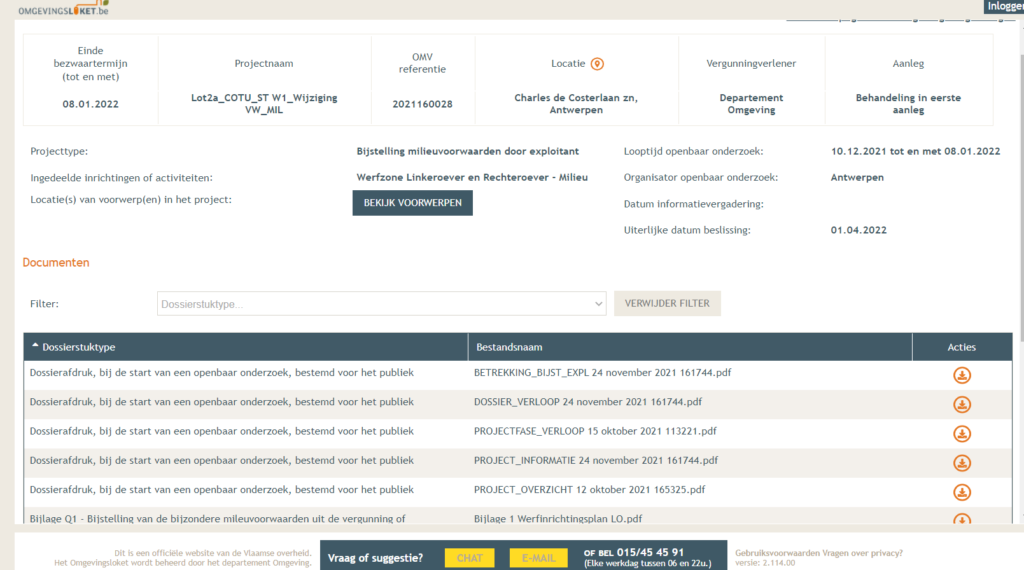
STEP 4. CLICK ON 'ADD NEW OBJECTION'
Click on 'ADD NEW OBJECTION' in the blue bar at the bottom.

STEP 5. SIGN UP / LOG IN
Log in with Itsme, an eID card reader or another method.
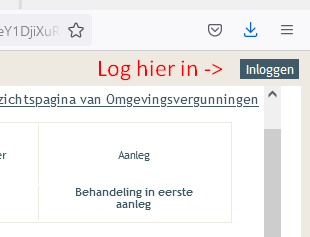

STEP 6. FILL IN THE FORM.
- enter your email address
- select what applies under “Representation”
- choose whether you want your objection to be visible to others > if so, check this box
- enter your objection in the large box and/or attach a file
- On the following pages of this manual you will find an example that you can copy
- Fill in your name and address in the yellow marker on the example!
- click SUBMIT!
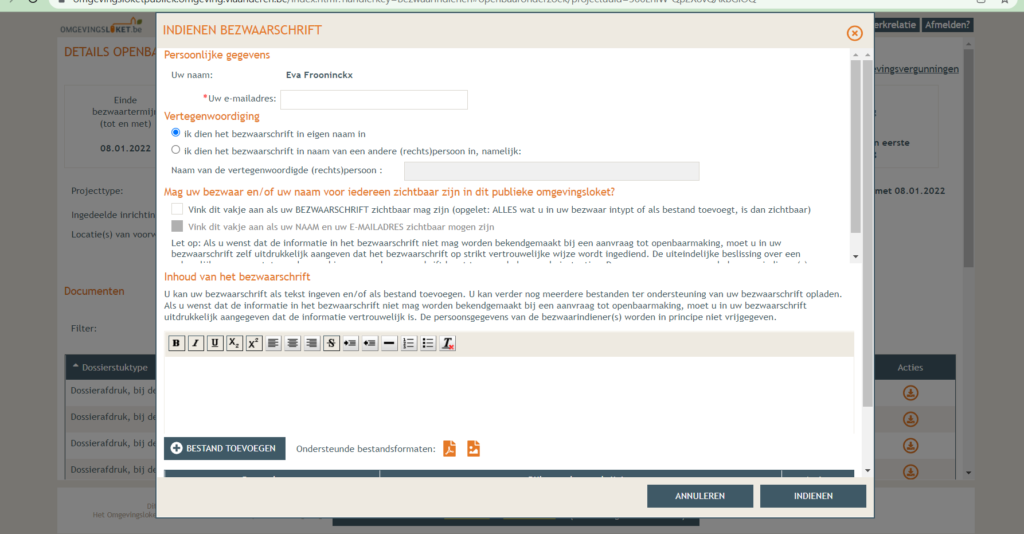
EXAMPLE Letter of Objection
Select the entire text and image below, copy and paste it into the “Contents of the appeal” field of your appeal.
Please note that after pasting the text you must enter your name and address (marked in yellow below) to personalize.
Of course you can also add your own comments.
copy from here
[ENTER YOUR NAME HERE]
[VUL JOUW VOLLEDIG ADRES HIER IN ]
[ENTER YOUR PLACE OF RESIDENCE HERE]
—————————————————————————————————————————–
At:
Organizers of the public inquiry:
The College of Mayor and Aldermen of the City of Antwerp
Attn: Permits Department, Grote Markt 1, 2000 Antwerp.
Permitting authority:
The Department of Environment of the Flemish Government
Department of Area Development, Environmental Planning and Projects
Directorate of Area Development
Team Mer
King Albert II Avenue 20 box 8, 1000 Brussels
mailto:mer@vlaanderen.be
—————————————————————————————————————————–
OBJECTION
————————————————————————————————————–
Tegen een omgevingsvergunning bijstelling milieuvoorwaarden door exploitant voor werfzone Linkeroever en Rechteroever met projectnaam ‘Lot2a_COTU_ST W1_Wijziging VW_MIL’, op Charles de Costerlaan zn, 2050 Antwerpen.
Vergunningaanvrager: THV Cotu, Laarstraat 16, 2610 Antwerpen
Ref. OMV 2021160028
————————————————————————————————————–
Dear,
Ik dien met dit bericht formeel een bezwaarschrift in in het kader van het lopend openbaar onderzoek naar de aanvraag voor een omgevingsvergunning ‘Lot2a_COTU_ST W1_Wijziging VW_MIL’ (OMV referentie 2021160028). Deze omgevingsvergunning omvat bijstellingen van volgende bijzondere voorwaarden verleend in omgevingsvergunning met dossiernummer OMV/2020142147:
– Het afdekken van grondtransporten van gronden met code 429! (bijzondere voorwaarde 5 uit huidige OMV ST W1).
– De lokale beneveling van de locatie waar gronden met code 429! worden afgegraven bij droge weersomstandigheden en stofvorming (bijzondere voorwaarde 5 uit huidige OMV ST W1).
– De bevochtiging (met sproeiwagen) van de verharde werfwegen en onverharde pistes bij droge weersomstandigheden en stofvorming (bijzondere voorwaarde 5 uit huidige OMV ST W1).
Regelmatige natte veging van de verharde werfwegen (bijzondere voorwaarde 5 uit huidige OMV ST W1).
– Het gebruik van niet-verontreinigd (bemalings)water bij de beneveling van de locatie waar de activiteiten worden uitgevoerd (bijzondere voorwaarde 5 uit huidige OMV ST W1).
– Om de stofbeheersingsmaatregelen ter hoogte van de werfzone LO te controleren, wordt in samenspraak met een MER-deskundige in de discipline lucht, deeldomein luchtverontreiniging, op een geschikte locatie een meetstation voor stof voorzien en stofmeetactieplan opgesteld. Het stof meetactieplan voorziet in een meetcampagne waarbij via stofstalen het gehalte opwaaiend stof, en de gehaltes aan PFAS in deze stalen, afkomstig van de werfzone LO/ST gemeten wordt. In het werkplan wordt de locatie van dit meetstation aangeduid en het stofactieplan ter hoogte van dit meetstation opgenomen. Voor de invulling van deze bijzondere voorwaarde kan gebruik gemaakt worden van stofmeetcampagnes die door derden worden opgezet (bijzondere voorwaarde 9 uit huidige OMV ST W1).
Deze omgevingsvergunning omvat ook BIJKOMENDE en NIEUWE bijzondere voorwaarden:
– COTU vraagt volgende aanvullende voorwaarde aan “Transport van met PFAS aangerijkte grond (meer dan 3 μg/kg ds PFOS/PFOA en/of meer dan 8 μg/kg ds PFAS – OVAM richtlijnen) van op de werf doorheen de omliggende woonkernen – meer bepaald Zwijndrecht, Burcht en Antwerpen Linkeroever – is niet
toegelaten. Er wordt hierbij verder maximaal gebruik gemaakt van het werfwegennetwerk.”
– COTU vraagt volgende aanvullende voorwaarde aan: “Teneinde de opvolging van de vordering van het grondverzet te faciliteren, informeert de exploitant, COTU, OVAM en de VMM – dienst Luchtkwaliteit maandelijks, via het bezorgen van een actueel situatieplan over de (werfgebonden) tussentijdse opslagplaatsen ((W-)TOPS) en meldt de exploitant hierbij welke zones afgewerkt zijn binnen de werfzone van COTU. Bij afwerking van het project wordt het werkplan hiervan overgemaakt.”
The image below, based on research conducted by the permit applicant itself, shows that the project area to which the permit application applies falls within a zone that is heavily polluted with PFAS, including PFOS. Via dit schrijven maak ik bezwaar bij het verlenen van een vergunning voor ‘Lot2a_COTU_ST W1_Wijziging VW_MIL’ (OMV referentie 2021160028)’, zolang de impact op de omgeving, waaronder Habitatrichtlijngebieden en Vogelrichtlijngebieden, de bevolking en de menselijke gezondheid niet wordt onderzocht zoals vereist door de geldende wetgeving inzake milieueffectenrapportering. Bovendien dient deze vergunningsaanvraag te worden geëvalueerd in het licht van het arrest van de Raad van State van 29 december 2021(nr. 252.567 van 29 december 2021 in de zaak A. 235.240/VII-41.264).
- A sufficient project EIA was never drawn up for the basic permit
First of all, it should be noted that for the basic permits for which the current environmental permit application constitutes a partial amendment, environmental impact assessments in accordance with the applicable legislation were never conducted. For example, the impact on the environment of earthmoving works in areas contaminated with PFAS was never (adequately) investigated. This was confirmed during the hearings of the Parliamentary Inquiry Committee PFAS-PFOS, including on 27 August (by Isabelle Larmuseau, KU Leuven).
In view of this PFAS contamination, no adequate water and soil test was carried out for this and other permits; nor was the impact of the planned earthmoving on the groundwater adequately studied; nor was the impact of the works on nearby protected nature reserves investigated.
Consequently, reference cannot be made to the basic permit to argue that the environmental impact of the works for which a permit is currently being requested should not be investigated.
- No adequate research into environmental impacts
The documents accompanying the current permit application also do not show that the possible effects of PFAS on the environment were investigated in a manner that is consistent with the applicable legislation on environmental impact assessment.
After all, there was still no adequate water and soil test; nor was the impact of earthmoving mentioned in the permit application on the groundwater adequately studied; nor was the impact on nearby protected nature areas (Habitat Directive areas, Bird Directive areas) investigated.
It is also important that it has recently emerged that (permitted or unpermitted) discharges from 3M Belgium contain, in addition to PFOS, other toxic PFAS compounds (PFOA, FBSA, PFBSA, MeFBSA, MeFBSAA). Consequently, the effect of the works to which the application relates must also be investigated, given the possible presence of these substances in the project area.
It is important to note that VMM recently measured an excess of PFBA in the air 100 metres from the Sint-Anna beach. Remarkably high concentrations of PFBA were measured in the months of August, September and October. From the Apache article dated 27/12/2021: “The researchers investigated at nine measuring points in the wider area around 3M how much PFAS is deposited on the soil via air deposition. At the measuring point on the Wandeldijk on the Left Bank, next to the Sint-Anna beach, an average of 213.7 nanograms of PFBA (ng/m²/day) was measured daily per square metre. For comparison: the amount of deposited PFOS measured at the same location, responsible for the historical pollution of the area around 3M, was 2.4 ng/m²/day in the same period. The difference is very large at the Sint-Anna beach. At other locations, the differences between PFBA and PFOS are less significant, but PFBA is still present in significantly higher doses than PFOS almost everywhere. The results of all measuring points added together, PFBA accounts for 55% of the measured precipitated PFAS. For PFOS, this is 13%.”
Since no adequate research has been carried out into the environmental impact of the planned works, a permit cannot be granted.
- Extent of PFAS pollution unprecedented
There is no detailed data available on PFAS pollution in the area to which the permit application relates. As a result, it seems difficult or impossible to assess the effects of the works on the environment and public health. For example, it will be difficult to determine whether the standstill principle is being respected.
This lack of information also makes it impossible for the advisory and licensing authorities to make a sufficient assessment of the environmental impact of the works (in an area polluted with PFAS) for which a permit is requested. Additional research is therefore required before a permit can be granted.
- The application does not take into account the most recent insights and standards regarding PFAS
In view of the EFSA 2020 standards, it also appears that the standard framework used is outdated. In September 2020, EFSA reduced the European reference dose to 0.63 ng/kg bw/day for the sum of PFOS+PFOA+PFHxS+PFNA. This implies that the current soil standard of 70 µg/kg ds is based on a cumulative underestimation of the toxicity of PFOS by a minimum factor of 1,020x (4,500 ng/L versus 4.41 ng/L). The standard used is in stark contrast to standard frameworks used elsewhere, where similar pollution problems occur. For example, with regard to the pollution in Dordrecht (PFAS pollution by Chemours), the rule is applied not to excavate soil above 3 micrograms/kg ds.
On Thursday 16/12/2021, the Antwerp Court of First Instance declared admissible an environmental injunction action that questions the framework of standards used, because it is not based on the most recent scientific insights.
Given the environmental duty of care, which obliges the permit applicant to take all measures to prevent damage and nuisance, the permit application should in principle be assessed on the basis of the most recent insights. In this case, this was not done; consequently, no permit can be granted.
- Remediation and/or waste disposal obligation
In any event, the advisory or licensing authorities must investigate whether there is no obligation to remediate or dispose of waste in relation to the PFOS contamination in the area to which the permit application relates.
As confirmed by the Council for Permit Disputes (14 January 2021), remediation of a project area may be required before work can commence in a contaminated area.
In addition, it must be examined whether, in view of the provisions on environmental criminal law, the waste disposal obligation must not be fulfilled before the works are started. This has not happened in the present case either.
- Judgment of the Council of State (no. 252.567 of 29 December 2021 in case A. 235.240/VII-41.264)
The Council of State ordered the suspension of the execution, in case of extreme urgency, of the declaration of conformity by the non-profit organisation Grondbank with no. 2015-16-210737 of 3 December 2021 of the update of the Technical Report on infrastructure works on the Left Bank dated 19/12/2019, with reference OWL1-SBSRTS-RAP-0001; the declaration of conformity by the non-profit organisation Grondbank with no. 2046-19-305809 of 3 December 2021 of the update of the Technical Report on the Scheldt Tunnel and Linkeroever connection dated 21/11/2020, with reference OWVA-SBS-BAM-RAP-0027.
She bases the above decision on the fact that the earthmoving works are not in accordance with the earthmoving regulations.
The Council of State decided that the work zone for the Oosterweel works was not correctly demarcated. According to the court, the area of the works – which extends over several kilometres from the 3M site in Zwijndrecht to Antwerp-Linkeroever and the Scheldt – does not form a single work zone, but a set of three separate construction projects, each of which has been permitted in a different way. This earth movement on the work zone cannot be legally valid. This was also confirmed in the press by client Lantis on 30/12/2021.
During the hearing, the Auditor at the Council of State was also particularly critical of the approach at the Oosterweel site. The auditor stated that the soil excavated by BAM should be qualified as waste, as stipulated in the materials decree. This waste may not simply be dumped in a so-called 'safety berm' on the 3M site. According to the Auditor, internal BAM documents show that the qualification as a 'safety berm' is merely a pretext. This term was explicitly created in the settlement between 3M and Lantis, in order to prevent the soil storage from having to be licensed as a landfill.
The suspension of the declaration of conformity of the Technical Reports for the Oosterweel works by the Council of State obviously also has consequences for this permit application. First of all, the permit application states that various recommendations of the Earthmoving Commission (led by Mr. Vrancken) were incorporated in the new technical reports. However, the declaration of conformity of these Technical Reports was suspended by the Council of State.
Since both illegalities have not been remedied in the current state of the permit procedure, the permit cannot be granted.
- European directives POP regulation
Er dient ook op te worden gewezen dat al sinds 2019 een Europese verordening geldt voor zogeheten persistente organische stoffen (POP), waar ook PFAS-achtige chemicaliën onder vallen. Deze POP-verordening bepaalt heel duidelijk dat er een verbod bestaat op de toepassing of het hergebruik van met PFOS vervuilde grond*. Bovendien worden overtredingen zwaar strafrechtelijk gesanctioneerd**.
Currently, a question concerning the interpretation of the POP Regulation is pending with the European Commission. It seems appropriate to wait with granting a permit until an answer to that question has been received. Only if the answer confirms the approach proposed in the permit application, a permit can be granted.
- Monitoring plan provides no guarantees for the safety of local residents
In de huidige vergunningsaanvraag wordt ook verwezen naar de ‘Bijlage 2 Monitoringsplan stof PFAS-metingen ILO_ST_V3’. De daarin beschreven werkwijze voor luchtmetingen is niet aangepast aan de specifieke situatie van Zwijndrecht. Het bloedonderzoek van 800 personen van de Vlaamse overheid en het bloedonderzoek van 10 personen door Grondrecht, heeft aangewezen dat omwonenden reeds veel te hoge PFOS/PFAS bloedwaarden in hun bloed hebben. Het toonde aan dat maar liefst 90% van de deelnemers van het bloedonderzoek reële kansen hebben op gezondheidseffecten o.w.v. te hoge PFOS/PFAS waarden in hun bloed. Het onderzoek van de Vlaamse Overheid had dan ook als besluit dat de blootstellingen van de omwonenden voor PFAS tot het absolute minimum moet herleid worden. Uit de voorgeschreven werkwijze blijkt niet dat die garantie er is.
De vooropgestelde toetsingswaarden van 0,4 – 2,2 ng/m³ voor de som van de 4 PFAS verbindingen (PFNA, PFOA, PFHxS en PFOS), opgesteld door VITO en VMM, houdt geen rekening met het feit dat de omwonenden reeds veel te hoge PFOS/PFAS bloedwaarden hebben. Er dient een toetsingskader te worden voorzien dat rekening houdt met deze kwetsbaarheid.
Kortom, de ‘bijlage 2 Monitoringsplan stof PFAS-metingen ILO_ST_V3’ geeft geen garanties dat de veiligheid en de gezondheid van de omwonenden gegarandeerd wordt. Bijgevolg kan er geen vergunning worden verleend voor de bijstellingen en de nieuwe voorwaarden waarvan sprake in deze vergunningsaanvraag.
General decision:
Based on the objections described under Titles 1 to 8, it must be concluded that in the current state of the application, insufficient research has been conducted into the effects that can be expected on local residents and the environment if a permit is granted.
For example, no adequate EIA was conducted for these works; nor was the impact of earthmoving on the groundwater adequately studied; nor was the impact of the works adequately investigated on nearby protected nature areas (Habitat Directive areas, Bird Directive areas) and on the population and human health. For example, the biomonitoring plan does not provide sufficient guarantees for the health and safety of local residents.
Due to the ruling of the Council of State dated 29/12/2021, no earthmoving is possible within the cadastral work zone because the declarations of conformity for the infrastructure works LO and Schelde were suspended. There are therefore no valid Technical Reports available, which means that excavation of soil and earthmoving is not possible. The legality objections raised by the Council of State and its Auditor must be resolved before a permit can be granted.
Finally, a question is pending with the European Commission on the interpretation of the POP Regulation; it is appropriate to await a response in that procedure before granting a permit.
Consequently, for all the above arguments, it is appropriate not to grant the permit at this time.
* REGULATION (EU) 2019/1021 OF THE EUROPEAN PARLIAMENT AND OF THE COUNCIL of 20 June 2019 on persistent organic pollutants.
** https://www.tijd.be/politico-economie/belgie/vlaanderen/het-europese-zw-van-damocles- Boven-oosterweel/10356595.html.



